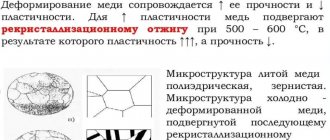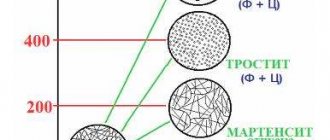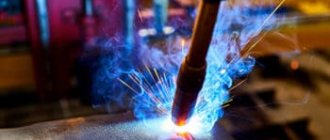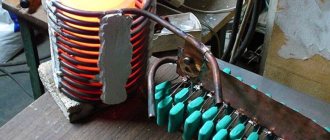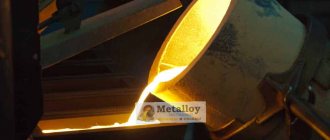Most of the operations associated with heat treatment involve the same algorithm of actions:
- heating the product to certain temperatures;
- holding under the influence of the set temperature for a specified time;
- cooling, which can be carried out in different environments and at different rates.
Heat treatment of parts can act both as an intermediate technological process and as a finishing one. In the first case, those parts that will still be processed, for example, drills or aircraft turbine blades, pass through it. The second case implies that after heat treatment, the finished part will receive new properties.
Steel normalization is a type of heat treatment of metal followed by cooling in air. The result of this operation is the formation of a normalized steel structure. By the way, this is where the name comes from. The operation is used in relation to forgings, castings, etc. Normalization is used to minimize grains in the steel structure formed by the weld.
The essence of the process
The normalization procedure is as follows. The part is heated to temperatures that exceed the maximum permissible parameters (Ac1, Ac3) by 30 - 50 degrees Celsius, then it is kept at this temperature for some time, after which it is cooled.
The temperature is selected based on the steel grade. Thus, alloys containing 0.8% carbon, so-called hypereutectoid, are processed at temperatures lying between the critical points Ac1 and Ac3.
What are critical points? This is the name given to the temperatures at which phase changes and structure of the alloy occur when it is heated or cooled.
The result of this is that a certain volume of carbon enters the solid solution and austenite is fixed. That is, a structure consisting of martensite and cementite appears. It is cementite that leads to an increase in wear resistance and hardness. Heating high-carbon steel above ac3 leads to an increase in internal stresses. This is due to the fact that the amount of austenite increases due to an increase in carbon concentration.
When heated above the critical point Ac3, steel with a carbon content of less than 0.8% acquires increased viscosity. This happens because in steel of this type austenite (fine-grained) appears, turning into martensite (fine-grained).
Hypoeutectoid steel is not processed at temperatures in the range Ac1 - Ac3. Since in this case ferrite appears, which reduces the hardness parameters.
Time required to complete the operation
It takes some time to obtain a homogeneous structure of the alloy at a certain temperature. This time will be determined as the holding time of steel during normalization. It was experimentally determined that a layer of metal 25 mm thick becomes homogeneous after an hour. Thus. and determine the normalization time.
The final stage is cooling
The cooling rate plays a significant role in the formation of perlite volume and the size of its plates. Numerous studies have shown that high cooling rates increase the amount of perlite and the steel gains increased hardness and strength. Low cooling intensity leads to steel losing hardness and strength.
When processing parts with significant differences in size, for example. shafts, it is advisable to remove stresses arising under the influence of temperature fluctuations. To do this, they are preheated in a container filled with different salts. When the temperature drops, it is possible to speed up this process by placing hot parts in water or specially selected oil.
In other words, steel normalization eliminates stress inside the part and minimizes its structure. That is, it has a direct effect on changes in the microstructure of steel alloys.
Defects during normalization
Since the normalization process is quite complex, during its implementation various defects may appear in the workpieces. Their main reasons are violation of the conditions of the heating and cooling stages prescribed in the technological map, as well as the negative influence of heated gases in the working volume of the furnace. Only the most critical defects are presented below.
Decarbonization
This defect occurs when a product located in an environment with oxidizing properties is heated to a high temperature value. It manifests itself in burnout in the surface layer of the carbon element.
Preventing the occurrence of this defect is carried out by placing the workpiece during heat treatment in protective or even simply neutral gas environments. In general, this can be argon (Ar) and helium (He). Another option is heat treatment in a vacuum, for example, using an induction unit. The principle of its operation is shown in the figure.
Oxidation
This defect appears as a result of a chemical reaction between two elements - iron (Fe) and oxygen (O2). Its formula is:
3Fe + 2O2=FeO▪Fe2O3
This defect occurs most often in fiery and electric furnaces. It manifests itself in the form of scale formation on the surface of a metal workpiece, forming shells. And here induction heating in a protective gas environment comes to the rescue, preventing oxidation of the steel.
Underheating
The occurrence of underheating is mainly due to:
- insufficient metal holding time;
- placing the workpiece in an oven that is not heated to the required temperature.
This defect manifests itself in the creation of the core of the product, which is characterized by a coarse-grained structure and also has an increased density. Its correction is carried out by repeated, but correct, operation of heating the workpiece.
Overheat
The reason for this defect is the heat treatment of the metal in a furnace at a temperature exceeding that established by the technological map. As a result, the product will be of low quality, and its structure will be dominated by large grains. Overheating can be eliminated. It is corrected by the operation of normalization and annealing.
Burnout
Burnout is included in the category of irreparable defects. It occurs when the metal is heated to a point close to the melting point in an environment with oxidizing properties. As a result of burnout, oxide inclusions appear on the outer edges of the grains, reducing the degree of ductility and the level of strength properties of the alloy. Prevention of this defect is ensured by strict adherence to the temperature characteristics of the workpiece heating procedure.
Using Normalization
This form of heat treatment is used to achieve different purposes. Thus, the use of normalization can increase or decrease the hardness of a steel alloy, toughness and strength characteristics. This method of heat treatment is used when it is necessary to improve the machinability of steel using different methods - cutting, stamping, etc.
Parts produced by casting undergo normalization in order to obtain a homogenized structure and eliminate internal stresses. The same can be said about parts obtained after forging. That is, normalization serves to obtain a homogeneous metal structure and eliminate internal stresses. In addition, this process can be used as a replacement for hardening products with complex profiles. In addition to the mentioned results of the normalization process, you can add such results as minimizing grains in the alloy structure, removing secondary cementite, and increasing the machinability of steel.
Purpose
Normalizing steel has different functions other than increasing its hardness. In some cases, normalization is carried out with the opposite purpose to reduce strength and toughness.
The main goals of metal normalization include:
- Obtaining the result of stress leveling. After processing, the steel has additional parameters, which makes it easier to process it in different ways.
- Reducing the heterogeneity and banding of the structure. In this case, objects are subjected to normalization after forging or rolling using the pressure method.
- Reducing the risk of deformation of parts that have sharp differences in cross-section or a complex configuration.
- Changing the coarse-grained structure of steel to fine-grained. Normalization helps to remove the network of secondary cement in hypereutectoid steel, improving its ability to be processed and hardened.
This technique is used to prepare metal for heat treatment at the final stage of the technological process.
Essentially similar heat treatment processes
In addition to normalization, the following operations can be added to the list of heat treatment of steels:
- annealing;
- vacation;
- hardening;
- cryogenic treatment and several others.
The annealing operation provides a high-quality, finer structure of pearlite; this occurs because furnaces are used to cool the parts. The purpose of this operation is to reduce the heterogeneity of the structure, remove stress, and increase machinability.
The principles underlying the hardening operation are identical to those of normalization, but there are some differences. For example, when hardening, much higher temperatures and high cooling rates are used. Hardening leads to improved strength characteristics, hardness, etc. But often workpieces that have undergone hardening are characterized by reduced viscosity and high fragility.
Tempering of parts is used after the hardening operation. Tempering reduces brittleness and internal stress. In this case, the temperature range is lower than that used in normalization. The parts are cooled in air. As the temperature increases, the tensile strength and hardness decrease and at the same time the impact strength increases.
Cryogenic treatment of steel results in a uniform metal structure and increased hardness. This processing technology is used for hardened carbon steel.
Normalization
Annealing
Chapter 7. PRACTICE OF HEAT TREATMENT OF STEEL
Heat treatment of steel consists of heating to a certain temperature, holding and cooling. Main heat treatment parameters:
the heating temperature is selected based on the ongoing phase transformations in the solid state,
The cooling rate (cooling medium) is selected depending on the need to obtain a particular structure.
The holding time at the heating temperature should ensure heating of the part by volume and completion of phase transformations.
Types of heat treatment:
annealing,
normalization,
hardening
vacation.
Annealing, normalizing and hardening are based on the decomposition of austenite upon cooling. Tempering is based on the transformation of martensite upon heating.
The purpose of annealing is to obtain an equilibrium structure. This is achieved by slowly cooling the part together with the furnace (Fig. 38). The structures of steels after annealing correspond to the equilibrium phase diagram (Fe-Fe3C):
hypoeutectoid - P+F,
eutectoid - P,
hypereutectoid – P+CII.
Rice. 38. Diagram of isothermal decomposition of austenite for eutectoid steel with cooling rates plotted on it for various types of heat treatment
Types of annealing:
Recrystallization annealing is carried out to remove hardening. The heating temperature of steels is 650...700°C (Fig. 39).
Annealing to relieve residual stresses (in castings, welded joints, etc.) is carried out at a temperature of 550..650°C.
Diffusion annealing (homogenization) is used for alloy steels in order to eliminate chemical and structural heterogeneity, Theat = 1100..1200°C (Fig. 39), holding time 15..20 hours. After diffusion annealing, a coarse-grained structure (P+F) is formed.
Full annealing is carried out for hypoeutectoid steels in order to obtain a fine-grained equilibrium structure with reduced hardness and high ductility and relieve internal stresses. Complete annealing is carried out at a temperature 30..50°C above the AC3 line (Fig. 38), complete phase recrystallization occurs, the structure is P+F, fine-grained. Full annealing of hypereutectoid steels is not used, as it leads to the formation of a P+CII structure with a brittle cementite network.
Partial annealing of hypoeutectoid steels is carried out at a temperature 10...30°C above the AC1 line (Fig. 39) in order to reduce hardness to improve cutting. Partial recrystallization occurs. Used instead of full annealing if grain refinement is not required.
For hypereutectoid steels, only partial annealing is prescribed. It is carried out at a temperature 10...30°C above line AC1 (Fig. 39) in order to obtain granular perlite. This type of annealing is called spheroidizing.
Isothermal annealing is used for alloy steels and consists of heating above the AC3 line, rapid cooling to 620...660°C, followed by isothermal exposure for 3...6 hours until complete decomposition of austenite with the formation of lamellar sorbitol. Next is cooling in air.
Rice. 39. “Steel corner” phase diagram of Fe-Fe3C with plotted heating temperatures for various types of annealing
Normalization is heating hypoeutectoid steels by 40...50 °C above AC3, hypereutectoid steels by 40..50 °C above ACm, holding and subsequent cooling in still air (Fig. 38, 40).
Rice. 40. “Steel corner” phase diagram of Fe-Fe3C with plotted heating temperatures during normalization
When heated, complete phase recrystallization occurs, and as a result of cooling, highly dispersed ferrite-cementite mixtures are obtained. Structures:
hypoeutectoid steels - S+F,
eutectoid – C,
hypereutectoid – C+CII.
After normalization, steel has higher strength, hardness, and resistance to brittle fracture compared to annealing.
The purpose of normalization is to eliminate the coarse-grained structure obtained during previous processing (casting, hot rolling, forging or stamping, diffusion annealing). Normalization is applied:
for low-carbon steels - instead of annealing,
for medium-carbon steels - instead of hardening with high tempering,
for high-carbon (hypereutectoid) - for partial elimination of the cementite network,
for some alloy steels - instead of hardening.
Annealing
Chapter 7. PRACTICE OF HEAT TREATMENT OF STEEL
Heat treatment of steel consists of heating to a certain temperature, holding and cooling. Main heat treatment parameters:
the heating temperature is selected based on the ongoing phase transformations in the solid state,
The cooling rate (cooling medium) is selected depending on the need to obtain a particular structure.
The holding time at the heating temperature should ensure heating of the part by volume and completion of phase transformations.
Types of heat treatment:
annealing,
normalization,
hardening
vacation.
Annealing, normalizing and hardening are based on the decomposition of austenite upon cooling. Tempering is based on the transformation of martensite upon heating.
The purpose of annealing is to obtain an equilibrium structure. This is achieved by slowly cooling the part together with the furnace (Fig. 38). The structures of steels after annealing correspond to the equilibrium phase diagram (Fe-Fe3C):
hypoeutectoid - P+F,
eutectoid - P,
hypereutectoid – P+CII.
Rice. 38. Diagram of isothermal decomposition of austenite for eutectoid steel with cooling rates plotted on it for various types of heat treatment
Types of annealing:
Recrystallization annealing is carried out to remove hardening. The heating temperature of steels is 650...700°C (Fig. 39).
Annealing to relieve residual stresses (in castings, welded joints, etc.) is carried out at a temperature of 550..650°C.
Diffusion annealing (homogenization) is used for alloy steels in order to eliminate chemical and structural heterogeneity, Theat = 1100..1200°C (Fig. 39), holding time 15..20 hours. After diffusion annealing, a coarse-grained structure (P+F) is formed.
Full annealing is carried out for hypoeutectoid steels in order to obtain a fine-grained equilibrium structure with reduced hardness and high ductility and relieve internal stresses. Complete annealing is carried out at a temperature 30..50°C above the AC3 line (Fig. 38), complete phase recrystallization occurs, the structure is P+F, fine-grained. Full annealing of hypereutectoid steels is not used, as it leads to the formation of a P+CII structure with a brittle cementite network.
Partial annealing of hypoeutectoid steels is carried out at a temperature 10...30°C above the AC1 line (Fig. 39) in order to reduce hardness to improve cutting. Partial recrystallization occurs. Used instead of full annealing if grain refinement is not required.
For hypereutectoid steels, only partial annealing is prescribed. It is carried out at a temperature 10...30°C above line AC1 (Fig. 39) in order to obtain granular perlite. This type of annealing is called spheroidizing.
Isothermal annealing is used for alloy steels and consists of heating above the AC3 line, rapid cooling to 620...660°C, followed by isothermal exposure for 3...6 hours until complete decomposition of austenite with the formation of lamellar sorbitol. Next is cooling in air.
Rice. 39. “Steel corner” phase diagram of Fe-Fe3C with plotted heating temperatures for various types of annealing
Normalization is heating hypoeutectoid steels by 40...50 °C above AC3, hypereutectoid steels by 40..50 °C above ACm, holding and subsequent cooling in still air (Fig. 38, 40).
Rice. 40. “Steel corner” phase diagram of Fe-Fe3C with plotted heating temperatures during normalization
When heated, complete phase recrystallization occurs, and as a result of cooling, highly dispersed ferrite-cementite mixtures are obtained. Structures:
hypoeutectoid steels - S+F,
eutectoid – C,
hypereutectoid – C+CII.
After normalization, steel has higher strength, hardness, and resistance to brittle fracture compared to annealing.
The purpose of normalization is to eliminate the coarse-grained structure obtained during previous processing (casting, hot rolling, forging or stamping, diffusion annealing). Normalization is applied:
for low-carbon steels - instead of annealing,
for medium-carbon steels - instead of hardening with high tempering,
for high-carbon (hypereutectoid) - for partial elimination of the cementite network,
for some alloy steels - instead of hardening.
Normalization and its application in practice
When assigning a heat treatment method, the technologist must take into account the carbon concentration. Steels in which the carbon content does not exceed 0.4% can be processed by both normalization and annealing. Normalization minimizes the grain size in the structure and increases strength characteristics.
Comparing the time spent between normalization and other methods, we can conclude that processing by other methods takes longer.
Due to the speed of the operation, the coverage of a large number of steels, the quality of the resulting parameters (hardness, strength, etc.), this is why normalization is widely used in mechanical engineering.
Rate this article:
Rating: 0/5 — 0 votes


